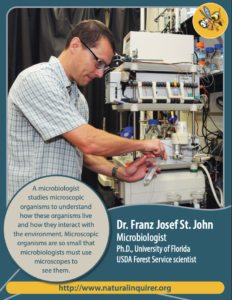Welcome to our website’s resource library, where we offer an extensive collection of free science materials tailored for K-12 students. Dive into a wealth of educational resources including articles, activities, lesson plans, learning modules, and much more. All materials are free to download!
-

 Science Communication
Science CommunicationAnnie Hermansen-Baez, Science Delivery Specialist

- Masters in Forest Resources and Conservation, University of Florida
- USDA Forest Service Scientist
- I translate science into terms that non-scientists can understand. I help scientist communicate with other natural resource professionals, students, and the general public.
- Masters in Forest Resources and Conservation, University of Florida
- USDA Forest Service Scientist
- I translate science into terms that non-scientists can understand. I help scientist communicate with other natural resource professionals, students, and the general public.
-


Franz Josef St. John, Microbiologist

- Ph.D., University of Florida
- USDA Forest Service Scientist
- A microbiologist studies microscopic organisms to understand how these organisms live and how they interact with the environment. Microscopic organisms are so small that microbiologists must use microscopes to see them.
- Ph.D., University of Florida
- USDA Forest Service Scientist
- A microbiologist studies microscopic organisms to understand how these organisms live and how they interact with the environment. Microscopic organisms are so small that microbiologists must use microscopes to see them.
-


Alan Rudie, Inorganic Chemist

- Ph.D., Massachusetts Institute of Technology
- USDA Forest Service Scientist
- Although an inorganic chemist by training, I have spent my career working on the science of wood pulping and bleaching to make paper. Pulping has aspects of inorganic chemistry, organic chemistry and chemical engineering.
- Ph.D., Massachusetts Institute of Technology
- USDA Forest Service Scientist
- Although an inorganic chemist by training, I have spent my career working on the science of wood pulping and bleaching to make paper. Pulping has aspects of inorganic chemistry, organic chemistry and chemical engineering.
-


Haiganoush Preisler, Statistical Scientist

- University of California, Berkeley
- USDA Forest Service Scientist
- As a statistical scientist I translate scientists’ hypothesis and word problems into a few (essential) equations that help further our understanding of the world we live in.
- University of California, Berkeley
- USDA Forest Service Scientist
- As a statistical scientist I translate scientists’ hypothesis and word problems into a few (essential) equations that help further our understanding of the world we live in.
-


Roderquita K. Moore, Research Chemist

- Ph.D., Clark Atlanta University
- USDA Forest Service Scientist
- Chemists have no limitations. We must be multifaceted to create, isolate, and characterize while utilizing a variety of chemicals and instrumentation.
- Ph.D., Clark Atlanta University
- USDA Forest Service Scientist
- Chemists have no limitations. We must be multifaceted to create, isolate, and characterize while utilizing a variety of chemicals and instrumentation.
-


JY Zhu, Research General Engineer

- Ph. D., University of California-Irvine
- USDA Forest Service Scientist
- As a research general engineer, I study things such as chemical and biochemical engineering, wood and fiber science, and bioenergy.
- Ph. D., University of California-Irvine
- USDA Forest Service Scientist
- As a research general engineer, I study things such as chemical and biochemical engineering, wood and fiber science, and bioenergy.
-


Samuel L. Zelinka, Research Materials Engineer

- Ph.D., University of Wisconsin-Madison
- USDA Forest Service Scientist
- A materials engineer develops and improves materials that you use in your everyday life by understanding and altering the microstructures of materials.
- Ph.D., University of Wisconsin-Madison
- USDA Forest Service Scientist
- A materials engineer develops and improves materials that you use in your everyday life by understanding and altering the microstructures of materials.
-


Alex C. Wiedenhoeft, Wood Anatomist

- Ph.D., University of Wisconsin-Madison
- USDA Forest Service Scientist
- A wood anatomist studies the relationships between the structure of wood and its functions and properties in the living tree, in a 2X4, or in a piece of trace evidence from a crime scene.
- Ph.D., University of Wisconsin-Madison
- USDA Forest Service Scientist
- A wood anatomist studies the relationships between the structure of wood and its functions and properties in the living tree, in a 2X4, or in a piece of trace evidence from a crime scene.
-


Xiping Wang, Research Engineer

- Ph.D., Michigan Technological University
- USDA Forest Service Scientist
- A research engineer studies the wood quality of raw forest materials, such as trees, stems and logs.
- Ph.D., Michigan Technological University
- USDA Forest Service Scientist
- A research engineer studies the wood quality of raw forest materials, such as trees, stems and logs.
-


Bob Ross, Research Engineer

- Ph.D., Washington State University
- USDA Forest Service Scientist
- Research engineers work on problems in a variety of areas. We work on everything from how a piece of material behaves when it is used to how to inspect historic artifacts.
- Ph.D., Washington State University
- USDA Forest Service Scientist
- Research engineers work on problems in a variety of areas. We work on everything from how a piece of material behaves when it is used to how to inspect historic artifacts.























